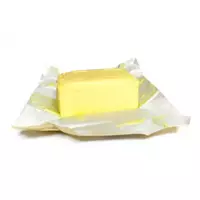Margarine dining room

Many modern culinary experts widely use food such as margarine in the process of preparing various culinary products. In the food industry, margarine is understood as an emulsion food product containing natural or modified animals and vegetable fats.
The history of margarine began in the 19th century, when the French emperor Napoleon III announced a monetary reward for the first to come up with a cheaper version of butter. A butter substitute was needed to accommodate the French soldiers. The monarch wanted to limit the cost of the diet of his army - this event was the starting point for researchers.
In the middle of the XIX century, the French chemist Hippolytus Meje-Murier was able to offer his budget version of replacing butter, which was later called margarine. Since then, the food manufacturer has constantly worked to improve the quality and taste and consumer characteristics of the product.
It is worth noting that depending on the production method, as well as the composition of the initial ingredients, margarine is divided into two main types - kitchen and dining. Table margarine has improved consumer and taste parameters in comparison with the kitchen type of the product. It is worth noting that it is really important for modern chefs to correctly select one or another type of margarine during the preparation of various culinary products.
Table margarine composition
It is believed that the composition of table margarine is closest in its main parameters to butter. For this reason, table margarine is often used to make sandwiches, as well as snacks and pastries. Even in appearance, table margarine is quite difficult to distinguish from butter. The interesting thing is that not only the appearance, but also the high-quality composition of table margarine is very close to butter.
In addition, the human body absorbs table margarine in the same way as butter. As a rule, butter contains about 84% fat, the same amount of fatty compounds is included in table margarine. Food manufacturers often introduce additional vitamins and minerals into table margarine. This is done in order to bring the vitamin-mineral composition of table margarine as close as possible to butter.
Milk starter is used in production of table margarine. In order to obtain a texture characteristic of butter, margarine table is emulsified. In the process of emulsification, all the composite ingredients of table margarine are firmly connected to each other and form a soft and uniform consistency of the finished product. There are two main types of table margarine - milk, as well as cream. The two types differ between themselves in chemical composition, as well as in the main consumer characteristics.
table margarine 743 kCal
Energy value of table margarine (Ratio of proteins, fats, carbohydrates - ju):
Proteins: 0.3 g (~ 1 kCal)
Fats: 82 g (~ 738 kCal)
Carbohydrates: 1g (~ 4kCal)
Energy ratio (bj | y): 0% | 99% | 1%
 Español
Español Français
Français Português
Português Русский
Русский 简体中文
简体中文 繁體中文
繁體中文 日本語
日本語 한국어
한국어 العربية
العربية Türkçe
Türkçe Қазақ
Қазақ Deutsch
Deutsch Italiano
Italiano Українська
Українська
